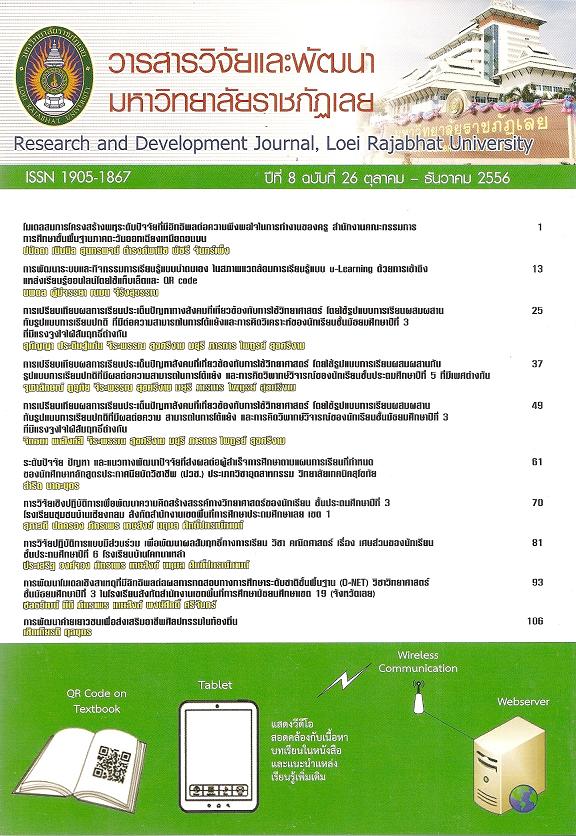การวิจัยเชิงปฏิบัติการเพื่อพัฒนาความคิดสร้างสรรค์ทางวิทยาศาสตร์ของนักเรียน ชั้นประถมศึกษาปีที่ 3 โรงเรียนชุมชนบ้านเชียงกลม สังกัดสำนักงานเขตพื้นที่การศึกษาประถมศึกษาเลย เขต 1
Keywords:
การวิจัยปฏิบัติการ, ความคิดสร้างสรรค์ทางวิทยาศาสตร์, action research, science creative thinkingAbstract
บทคัดย่อ
งานวิจัยครั้งนี้มีวัตถุประสงค์เพื่อ ศึกษาสภาพปัญหาความคิดสร้างสรรค์ทางวิทยาศาสตร์ของนักเรียน ความคาดหวังและแนวทางการพัฒนาความคิดสร้างสรรค์ทางวิทยาศาสตร์ ผลการพัฒนาความคิดสร้างสรรค์ทางวิทยาศาสตร์ และความพึงพอใจต่อการจัดกิจกรรมการเรียนรู้ เพื่อพัฒนาความคิดสร้างสรรค์ทางวิทยาศาสตร์ของนักเรียน กลุ่มตัวอย่างที่ใช้ในการวิจัยครั้งนี้คือ นักเรียนชั้นประถมศึกษาปีที่ 3 โรงเรียนชุมชนบ้านเชียงกลม สำนักงานเขตพื้นที่การศึกษาประถมศึกษาเลย เขต 1 จำนวน 18 คน เครื่องมือที่ใช้ในการวิจัย ได้แก่ แบบวัดความคิดสร้างสรรค์ทางวิทยาศาสตร์ แผนการจัดการเรียนรู้ แบบทดสอบท้ายวงจร แบบสอบถามความพึงพอใจ ประเด็นในการสนทนากลุ่ม แบบสัมภาษณ์เชิงลึก แบบบันทึกการสังเกตพฤติกรรมทางการเรียน แบบบันทึกประจำวันของครู แบบบันทึกการเรียนรู้สำหรับนักเรียน แบบบันทึกความก้าวหน้าทางการเรียน แบบบันทึกแสดงความคิดเห็นของนักเรียน สถิติที่ใช้ในการวิเคราะห์ข้อมูล ได้แก่ ร้อยละ ค่าเฉลี่ย ส่วนเบี่ยงเบนมาตรฐาน และสถิติทดสอบที (t-test) ผลการวิจัยสรุปได้ ดังนี้
1. นักเรียนชั้นประถมศึกษาปีที่ 3 โรงเรียนชุมชนบ้านเชียงกลม มีปัญหาความคิดสร้างสรรค์ทางวิทยาศาสตร์
2. ผลการศึกษา ความคาดหวังและแนวทางในการพัฒนาความคิดสร้างสรรค์ทางวิทยาศาสตร์ พบว่า ต้องการให้นักเรียนพัฒนาด้านความคิด กล้าแสดงออก มีทักษะขั้นพื้นฐานไปถึงขั้นความคิดสร้างสรรค์ เกิดการคิดได้เอง แก้ปัญหาในชีวิตประจำวันได้ คิดเป็นผ่านเกณฑ์การประเมินร้อยละ 50 - 60 แนวทางการพัฒนาควรกระตุ้นและให้แรงเสริม มีสื่อการสอนให้นักเรียนเห็นภาพและแสดงความคิดเห็นที่มีต่อภาพ โดยการใช้ภาพจิ๊กซอว์ ภาพจับคู่ มีการทวนซ้ำ แบ่งกลุ่มจัดกิจกรรม
3. ผลการพัฒนาความคิดสร้างสรรค์ทางวิทยาศาสตร์ของนักเรียน พบว่า
3.1 นักเรียนชั้นประถมศึกษาปีที่ 3 มีความคิดสร้างสรรค์ทางวิทยาศาสตร์หลังพัฒนาสูงกว่าก่อนพัฒนาอย่างมีนัยสำคัญทางสถิติที่ระดับ .01
3.2 นักเรียนชั้นประถมศึกษาปีที่ 3 มีคะแนนความคิดสร้างสรรค์ทางวิทยาศาสตร์หลังการพัฒนาสูงกว่าเกณฑ์คะแนนร้อยละ 60 อย่างมีนัยสำคัญทางสถิติที่ระดับ .01
4. ความพึงพอใจของนักเรียนชั้นประถมศึกษาปีที่ 3 ที่มีต่อการจัดกิจกรรมการเรียนรู้ เพื่อพัฒนาความคิดสร้างสรรค์ทางวิทยาศาสตร์ อยู่ในระดับมาก
Abstract
This research was designed to study the Prathomsuksa 3 students’ science creative thinking with the research purposes : 1) to investigate the students’ problems with the science creative thinking, 2) to find out the expectation and guidelines for development, 3) to explore the development results, and 4) to study the students’ satisfaction with the learning activity operation. The data were gathered from 18 Prathomsuksa 3 students at Chumchon Banchiangklom school, under the Office of Loei Primary Educational Service Area1 by a test of science creative thinking, a learning plan, the ended-loop tests, a questionnaire for satisfaction, focus group interview, in-depth interview, a form of observed behavior, a teacher’s daily record, students’ learning records, learning progress report and the students’ opinion records. The statistics used for data analysis were percentage, mean, standard deviation and t-test.
The research results showed that :
1. The Prathomsuksa 3 students in Chumchon Banchiangklom school’s problems with creative thinking aspect were found.
2. For the expectation, the results found were the development of students’ thinking, assertive, basic skills through the creative thinking, think for themselves and the capacity for problem solving based on the 50-60 percent criteria. For the guideline development, the enhancement and reinforcement should be performed. Besides the instructional medias should be implemented for teaching and learning then the students can figure the images out and present their opinions on the images by applying the jigsaw, matching the pictures, reviewing the content and group activity.
3. For the Prathomsuksa 3 students’ science creative thinking, the results indicated as follows :
3.1 The Prathomsuksa 3 students’ science creative thinking after development was higher than before development with the statistical significance at .01 level.
3.2 The Prathomsuksa 3 students’ scores of science creative thinking after development were higher than 60 percent criteria with the statistical significance at .01 level.
4. The Prathomsuksa 3 students were satisfied with the teaching activity at a high level.
Downloads
How to Cite
Issue
Section
License
ข้อความที่ปรากฎในวารสารฉบับนี้เป็นความคิดเห็นของผู้เขียนแต่ละท่าน สถาบันวิจัยและพัฒนา มหาวิทยาลัยราชภัฏเลย และกองบรรณาธิการ ไม่จำเป็นต้องเห็นด้วยและไม่มีส่วนรับผิดชอบใดๆ
สถาบันวิจัยและพัฒนา มหาวิทยาลัยราชภัฏเลย ขอให้ผู้อ่านอ้างอิงในกรณีที่ท่านคัดลอกเนื้อหาบทความในวารสารฉบับนี้






